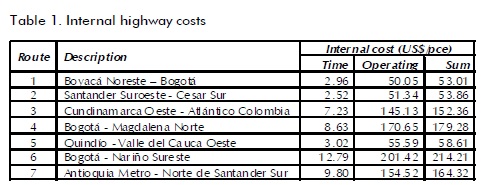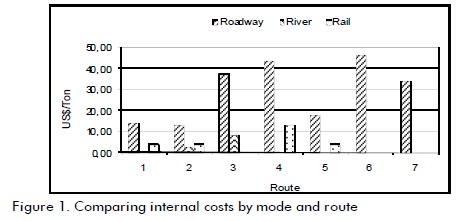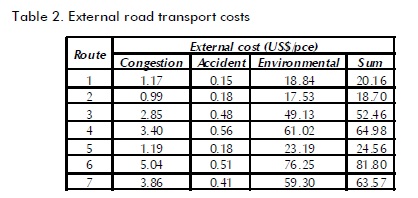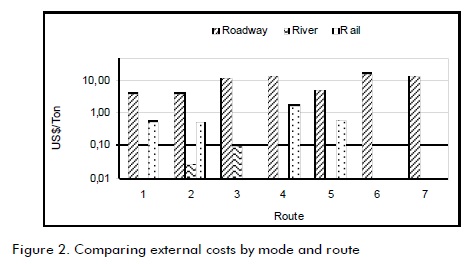Serviços Personalizados
Journal
Artigo
Indicadores
-
 Citado por SciELO
Citado por SciELO -
 Acessos
Acessos
Links relacionados
-
 Citado por Google
Citado por Google -
 Similares em
SciELO
Similares em
SciELO -
 Similares em Google
Similares em Google
Compartilhar
Ingeniería e Investigación
versão impressa ISSN 0120-5609
Ing. Investig. v.31 n.1 Bogotá jan./abr. 2011
Estimating marginal external costs for road, rail and river transport in Colombia
Luis Gaiel Márquez Díaz 1
1Transport and highways Engineer. M.Sc. in Engineering with emphasis on Transport, Universidad Pedagógica y Tecnológica de Colombia. Professor, School of Transport and Highway Engineering, Universidad Pedagógica y Tecnológica de Colombia. luis.marquez@uptc.edu.co
ABSTRACT
This report presents the results of research regarding strategic freight transport network modelling in Colombia using external cost. The model uses sequential equiliium between distribution and traffic assignment phases; it is national and inter-regional, involving strategic decisionmaking. The Colombian transport network consists of 27,469 km of roads, 11,257 km of navigable rivers, 2,192 km of railway lines and a set of centroid connectors for establishing a link with the zoning system (consisting of 70 internal areas and 8 external areas). Each link in a network involves internal costs: time, operation and external costs, congestion, accidents, air pollution and CO2 emissions. Vehicle ownership costs were excluded from internal cost analysis; costs such as noise, climate change and effects on the landscape were not studied in external costs. Marginal costs regarding the network were estimated by two methods. First, it was assumed that an additional unit of demand did not affect equiliium in a transport network and then marginal cost was estimated as being the sum of marginal costs regarding links in the shortest path. The other approach assumed that an additional unit of demand changed network equiliium; marginal costs were then estimated by calculating the difference between the two equiliium scenarios. The methods were applied to 7 selected routes covering the most important Colombian freight transport corridors. An average 0.014 US$/ton/km rate was estimated for external costs regarding highway transport, 0.000105 US$/ton/km for water transport and 0.001625 US$/ton/km for railroad transport (preponderance of environmental costs exceeding 90%).
Keywords: transport modelling, freight transport, external transport costs.
Received: December 2th 2009. Accepted: January 15th 2011
Introduction
Despite efforts made to model freight transport in Colombia, few studies have been made into transport modelling including external costs. The Colombian Ministry of Public Works and Transport sponsored the first study of freight transport, technical assistance being provided by the Netherlands' Economic Institute between 1979 and 1981. This study was updated in 1985, but could not be implemented and a Master Transport Plan was then developed, which ended in 1994. A Strategic Transport Plan was developed in 1998, technical assistance being provided by Cal & Mayor y Asociados from Mexico (2002); a methodology was applied that considered Colombia's economic and geographic conditions as well as the transport sector. Recently, the Transport Modelling Temporary Merger (TMTM or Unión Temporal Modelación del Transporte - UTMT, 2008), consisting of the Universidad Pedagógica y Tecnológica de Colombia, the Universidad Nacional de Colombia and Fundación Universidad del Norte, engaged in a research project to standardise a freight transport model for analysing its impact on transport networks during 2007 and 2008. Based on the results of this study, additional research was carried out by analysing internal and external costs in the strategic network being considered (Márquez, 2009).
By contrast, there are important references on freight transport modelling in the international arena, including external costs. Janic (2007) developed a model for comparing internal and external costs for an intermodal freight transport network in the European Union. Beuthe et al., (2002) studied the costs of freight transport externalities and suggested some internalisation strategies. Nijkamp et al., (2004) compared the descriptive and predictive power of two kinds of statistical estimation models for multimodal transport networks using a family of discrete choice models. Forkenock (2001) studied the costs of freight transport in the USA in four representative types of train, estimating private and external costs for each and evaluating their percentage differences. Ozbay et al., (2007) applied three alternative approaches for estimating marginal costs in a transport network by using assignment methods, such as all or nothing, incremental and user equiliium.
The present paper adapts a strategic freight transport model (TMTM, 2008) for studying internal and external costs (Márquez, 2009) whose parameters had been previously caliated to extract internal and external cost indicators and then estimate transport marginal costs for road, river and rail transport in Colombia,in the strategic network.
Transport costs in strategic networks
Total cost for each link in a strategic network in the model can be expressed as the sum of private travel time cost, internal operation cost and a set of external costs which included the following: congestion, accidents, air pollution, climate change and infrastructure. Costs such as noise and effects on the landscape, which could represent about 10% of external costs (ISIS et al ., 1998; INFRAS, 2004), have not been included in this study as being beyond its scope.
Most procedures used for solving the passenger car equivalent (PCE) assignment problem have relied on updating cost based on the volume-delay function. Although different formulations have been suggested (Branston, 1976, Davidson, 1966; Spiess, 1990,National Research Council, 2000), the Bureau of Public Roads' (BPR) Traffic Assignment Manual (1964) was chosen as it has been one of the most traditionally-used for updating transport network costs. Internal cost is determined in this mathematical function by free flow travel time, calculated as the ratio between length and free flow speed, traffic flow (expressed as vehicles per unit of time), link capacity (expressed in the same units as traffic volume), value of time (in monetary units per unit of time) and caliation parameters in BPR function, α and β.
While the social cost of congestion can be seen as an artificial measurement of inefficiency in using transport infrastructure (Doll, 2002), it is accepted that congestion also produces an externality. The best practice for estimating congestion cost is based on volume-delay functions, value of time and transport demand elasticity (Maibach et al., 2008). In this case, congestion marginal cost is calculated on marginal BPR cost for each link, maintaining the above parameters’ specification.
Although not as complex as the Rizzi model (2005), accident cost can be analysed by an adaptation of the Lindberg model (2002) allowing better specification than other formulations tested (ISIS et al., 1998; Beuth et al., 2002, FHWA, 2005; Ozbay et al., 2007). The total cost of an accident, according to Lindberg (2002), depends on the number of accidents and willingness to pay to reduce accident risk by individuals, their relatives and external cost in a system. The total marginal cost of accidents regarding traffic volume is deducted from total cost as being the number of accidents regarding traffic volume; an accident risk factor is found and external marginal cost then obtained by subtracting private cost internalised by a user.
Regarding environmental effects caused by transport (Bickel et al., 2006), which usually involve health, vegetation and property damage (Murphy and Delucci, 1998), generalized cost is used for simplifying analysis. Mahmod and van Arem (2008) have studied several traffic modelling approaches for estimating the amount of emissions, finding that models such as MOBILE (US EPA, 2003) can be used in large-scale applications; however, simpler models such as MODEM (Osses and Henríquez, 2002) which uses the emission factor technique (EEA, 2007), are also considered of interest as they establish a value representing the amount of pollutant released into the atmosphere regarding the associated activity which has produced it. Following this approach, air pollution costs are estimated from factors such as traffic flow, emission factor (in grams per vehicle per kilometre) and a caliation parameter which includes the cost of each pollutant.
Maintaining the same functional relationship and changing emission factors and cost parameters for each pollutant, the proposed formulation has been used to estimate the costs produced by carbon monoxide (CO), nitrogen oxide (NOx) and sulphur dioxide (SO2) emission.
Infrastructure cost has been calculated as average cost depending on the length and number of lanes representing each link. As cost is not a function of flow, the relationship between the travel time of an additional vehicle and the time between each maintenance cycle has been used because the marginal cost effect of an additional vehicle cannot be calculated directly (Ozbay et al., 2007).
Experimental approach
The strategic freight transport model developed by the TMTM (2008) was used for analysing transport demand in this investigation; it was based on product approach for estimating freight transport demand and adapting a four-step transport model. The model was designed at national level, involving strategic decision -making and zoning consisting of 70 internal and 8 external zones concentrating freight attracted or produced in Venezuela, the South Atlantic, the South Pacific, Ecuador, Tokyo, the US West Coast, the US East Coast and Rotterdam (Márquez, 2008).
Regarding transport supply, the network for strategically modelling freight transport in Colombia was formed by a selection of links and road, river and rail transport nodes, along with details concerning impedance variables, time and capacity required for using assignment methods. The Colombian transport network consists of 27,469 km of roads, 11,257 km of navigable rivers and 2,192 km of railway; the network also includes a set of connectors linking international external areas by sea and a set of connectors to connect centroids with inland areas.
Cost estimation considered 22 kinds of homogeneous link and a representative truck for highways, a typical convoy for river transport and a typical train for rail transport. Two alternative approaches were used for experimentally obtaining the value of time; one was based on cost factors and the other on discrete choice models (Fowkes et al., 1989). The other parameters were estimated using secondary data produced by Colombian entities.
Two different methods were used for calculating the strategic transport network's marginal costs:
Inertial condition equiliium: It was assumed that an additional unit of demand between OD pair did not affect transport network equiliium, meaning that the transport network has reasonable inertia up to a certain threshold of change in demand. In this case, total marginal cost (TMC) was calculated as follows:
- The shortest path between the given OD pair was determined;
- TMC was estimated for each link in the shortest path using the derivative of total cost for such link; and
- The TMC produced by an additional unit of freight transport emand between OD pair selected in the transport network was estimated as the sum of marginal costs in links in the shortest path.
Variation condition equiliium: It was assumed that one unit of demand for additional freight, between OD pair in the transport network would cause changes in existing equiliium, this being reasonable if the amount of demand for additional freight exceeded the threshold hypothetically keeping the transport network in equiliium. TMC was calculated in this second approach as follows:
- The stochastic user equiliium assignment method was used for assigning total freight demand between OD pair;
- Total transport network cost for equiliium reached was estimated by the assignment method;
- Freight transport demand between OD pair was increased by 1% on original freight demand for OD pair; and
- TMC for an additional unit was estimated by calculating the difference between total transport network cost for increased 1% TC1 demand and transport network cost in original equiliium TC0, and then dividing that difference by demand for extra cargo ΔOD assigned, as:

Results
All costs were estimated in US dollars for 2005. There was no difference between the results produced by both methods because demand for an additional 1% transport used in a method called "variation condition equiliium" was not sufficient to cause the expected change in equiliium.
Concerning road transport (Table 1), it was found that time cost represented 5% of total internal cost considered (on average), partially explaining this transport mode's predominance in Colombia since freight opportunity costs and greater delivery reliability are more attractive.

Internal convoy cost of time was 60% of total internal cost in river transport mode and this was possibly one of the reasons why river transport is used to transport goods having low opportunity cost.
Regarding rail transport, it was found that the value of time represented 30% of total internal cost. Comparing the results (Figure 1), it was found that internal road transport costs was 3.5 times larger than domestic river transport costs. There was a 2.4 ratio between road and rail transport modes and 1.7 ratio between rail and river transport modes.

Considering an average load factor, expressed in tons per vehicle for each mode of transport and an equivalent passenger car factor, internal cost indicators were obtained for each transport mode: 0.037 US$/ton/km for road transport, 0,0095 US$/ton/ km for river transport and 0.0135 US$/ton/km for rail transport.
The road transport results (Table 2) had a preponderance of external environmental cost regarding the other external cost components analysed. It was found that external environmental cost represented 94% of external road transport costs.

It also became clear that the external cost of accidents was the minor component because it failed to represent 1% of total external road transport cost which is reasonable since accidents are a major phenomenon in urban transport. Evaluating environmental costs (consisting of emission costs and the cost of CO2) represented total indirect water transport costs.
It was also found that environmental external cost was most important in rail transport, representing just over 87% of total external costs, followed by 12% external congestion cost. latter cost was particularly high; it was explained by how links modelling the way through railway stations were penalized and the low railway link capacity in BPR functions.
Comparing different transport modes' external costs (Figure 2) resulted in a 1:110 ratio for external road transport costs compared to river transport and 1:8 regarding rail transport (a 1:17 ratio was obtained for the only comparable route between river and rail modes.

An average external cost indicator for each transport mode was found: 0.014 US$/ton/km for highway transport, 0.000105 US$/ ton/km for water transport and 0.001625 US$/ton/km for railroad transport. External costs accounted for 37% of internal road transport costs, 12% for rail transport and just over 1% for river transport.
Conclusions
A strategic freight transport network in Colombia was modelled, including external costs, and the model was used for experimentally extracting internal and external cost indicators.
Adding marginal costs for the shortest path in each case studied led to marginal transport network costs being obtained with inertial equiliium methodology. The same results were obtained with variation equiliium because the additional amount of freight transport demand did not exceeded the threshold hypothetically maintaining transport network equiliium. When there was no network congestion, it was concluded that both methods were equivalent. it is recommended using the first method as it is simpler and easier to implement.
Vehicle ownership costs were not included when estimating internal costs, so the correct interpretation of results must consider this fact, especially when making comparisons with other costs.
Prospects for further research were identified, such as determining emission factors concerning pollutants and carbon dioxide produced by freight transport vehicles in Colombia's major transport corridors, willingness to pay for mitigating the environmental impact caused by freight transport vehicles, quantifying damage to Colombian road infrastructure by freight transport vehicles and estimating the value of a statistical life in Colombia to analyse the impact of accidents.
Notation
α: BPR function caliation parameter
β;: BPR function caliation parameter
TMC: total marginal cost
TC: total cost
TC0: cost of transport network in original equiliium
TC1: cost of transport network with 1% increase in demand
ΔOD: increasing transport de mand
PCE: passenger car equivalent
References
Beuthe M., Degrandsart F., Geerts J-F., Jourquin B., External costs of the Belgian interurban freight traffic: a network analysis of their internalisation., Transportation Research Part D 7, 2002, pp. 285-301. [ Links ]
Bickel, P., Friedrich, R., Link, H., Stewart, L. and NASH, C., Introducing Environmental Externalities into Transport Pricing: Measurement and Implications., Transport Reviews, Vol. 26, No. 4, July 2006, pp. 389-415. [ Links ]
Branston, D., Link Capacity Functions: A Review., Transportation Research 10, 1976, pp. 223-236. [ Links ]
Cal & Mayor y Asociados., Plan Estratégico del Transporte de Carga en Colombia., Documento Resumen, Ministerio de Transporte, Colombia, 2002, pp. 8-10. [ Links ]
Davidson, K. B., A flow travel time relationship for use in transportation planning., Australian Road Research Board 3, 1966, pp.183-194. [ Links ]
Doll, C., UNITE, Case Studies 7A to 7D - Inter-urban road and rail user costs UNITE., ITS, University of Leeds, Karlsruhe, 2002, pp. 3-4. [ Links ]
EEA, EMEP/CORINAIR, Emission Inventory Guidebook., Technical report Nº 16, Group 7: Road Transport, Chapter B710, 2007, pp. 8-10. [ Links ]
Federal Highway Administration (FHWA), Motor Vehicle Accident Costs, [Available online]: <http://www.fhwa.dot.gov/legsregs/directives/techadvs/t75702>, 2005, [Reference: 11-11-2008] [ Links ].
Forkenbrock, D., Comparison of External Costs of Rail and Truck Freight Transport, Transportation Research A, Vol. 35, No. 4, May 2001, pp. 321-337. [ Links ]
Fowkes, A.S., Nash, C.A., Tweddle, G., Valuing the attributes of freight transport quality: Results of the stated preference survey., working paper 276, ITS, University of Leeds, Yorkshire, 1989, pp. 7-16. [ Links ]
INFRAS,. External cost of transport., Update Study, Final Report, Zurich/Karlsruhe, October 2004, pp. 32-56. [ Links ]
Isis, E., Inestene, Z., Isi-Fraunhofer, Who-Eceh, Q., Quality Indicators for Transport Systems., Final Report for Publication, Contract n°: ST-96-SC-115, Rome, April 1998, pp. 28-55. [ Links ]
Janic, M., Modelling the full costs of an intermodal and road freight transport network., Transportation Research Part D 12, 2007, pp. 33-44. [ Links ]
Lindberg, G., Deliverable 9: Accident Cost Case Studies., Case Study 8d: External Accident Cost of Heavy Goods Vehicles, ITS, University of Leeds, 2002, pp. 3-19. [ Links ]
Mahmod, M., van Arem, B., A simulation framework for modelling the impacts of an integrated road-vehicle system on local air quality., Centre for Transport Studies, University of Twente, the Netherlands, TRAIL Research School, Delft, October 2008, pp. 1-10. [ Links ]
Maibach, M., Schreyer, C., Sutter, D., Handbook on estimation of external costs in the transport sector., Report, Delft, February, 2008, pp. 23-35. [ Links ]
Márquez, L., Propuesta de zonificación para la modelación estratégica del transporte de carga en Colombia., Actas del XV Congreso Panamericano de Tránsito y Transporte, Cartagena, septiembre de 2008. [ Links ]
Márquez, L., Modelación de una red estratégica de transporte de carga en Colombia utilizando costos de externalidades., tesis presentada a la Universidad Pedagógica y Tecnológica de Colombia, para optar al grado de Magíster en Ingeniería con énfasis en Transporte, Tunja, 2009. [ Links ]
Murphy, J. Delucci, M., A Review of the Literature on the Social Cost of Motor Vehicle Use in the United States., Institute of Transportation Studies, University of California, 1998, Paper UCD-ITS-REP-98-22. [ Links ]
National Research Council., Transportation Research Board., 2000 Highway Capacity Manual, Washington, D.C., 2000. [ Links ]
Nijkamp, P. Reggiani, A., Tsang, W.F., Comparative modelling of interregional transport flows: Applications to multimodal European freight transport., European Journal of Operational Research 155, 2004, pp. 584-602. [ Links ]
Osses, M., Henríquez, A., Modelo de emisiones vehiculares MODEM., Departamento de Ingeniería Mecánica, Universidad de Chile, Santiago, 2002, pp. 1-14. [ Links ]
Ozbay, K., Bartin, B., Yanmaz-Tuzel, O., Berechma, J., Alternative methods for estimating full marginal costs of highway transportation., Transportation Research Part A 41, 2007, pp. 768-786. [ Links ]
Rizzi, L.I., Diseño de instrumentos económicos para la internalización de externalidades de accidentes de tránsito., Cuadernos de Economía, número 126, 2005, pp. 283-305. [ Links ]
Spiess, H. Conical Volume-Delay Functions., Transportation Science 24, 1990, pp. 153-158. [ Links ]
Unión Temporal Modelación del Transporte UTMT., Investigación para desarrollar y poner en funcionamiento los modelos de demanda y de oferta de transporte que permitan proponer opciones en materia de infraestructura para aumentarla competitividad de los productos colombianos., Informe final, Bogotá, 2008. [ Links ]
U.S., Environmental Protection Agency EPA., User´s Guide to MOBILE6.1 and MOBILE6.2: Mobile Source Emission Factor Model, EPA420-R-03-010, august 2003, pp. 184-198. [ Links ]











 texto em
texto em 


